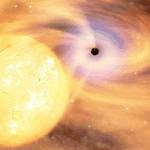 |
|
|
|
||
![]()
|
Stellar link helps black holes weigh in Huge black holes are thought to exist at the heart of every galaxy, but it is complicated and time-consuming to calculate their masses with existing techniques. Now this is set to change following the discovery that the mass of a black hole is related to the concentration of stars in its host galaxy. According to Alister Graham and colleagues at the Canaries Institute of Astrophysics in Tenerife, astronomers will now be able to calculate the masses of thousands of black holes quickly and accurately from snapshots of galaxies (A Graham et al 2001 Astrophys. J. Lett. to appear)
Black holes are enormously dense objects with a gravitational pull so strong that not even light can escape from them. Super-massive black holes are between a million and a thousand million times more massive than the Sun, and almost every galaxy is thought to harbour one. This means that any theory of galaxy evolution must account for black-hole formation, and vice versa. Earlier this year, Graham's team found that the mass of a black hole is related to the range of velocities of the stars that orbit it. They successfully calculated the mass of black holes from velocity measurements, but these measurements required long - and expensive - telescope exposures. The new technique relates the mass of a black hole to the distribution of mass in the central, dense region of its host galaxy. Graham and colleagues collected high-quality images of 23 of the galaxies investigated in the earlier study, and measured their luminosities. This allowed them to calculate the density of stars in these galaxies, from which they calculated the masses of their central black holes. They found that the black-hole mass is probably more closely associated with star distribution than it is with the velocity range of stars in the host galaxy. It may not sound surprising that the mass of a black hole is linked to the concentration of stars around it - the bigger a black hole, the larger its gravitational field and the more matter it would attract. But Graham and co-workers point out that this effect could also arise from a connection between the processes that shape galaxies and construct black holes. Astronomers are still unsure whether black holes existed in the early universe before galaxies formed. "This is an important realization, which provides further insight into the formation of both galaxies and their central black holes," says Graham. "We now know that any viable theory of super-massive black hole growth must be connected with the eventual structure of the galaxy". Author
|
|
|||||||||||||||||||||||||||||||||||||||||||||||||||||||||||||||||||||||||||||||||||||||||||||||||||||||||||||||||||||||||||||||||||||||||||||||||||||||||||||||||||||||||||||||||||||||||||||||||||||||||||||||||||||||||||||||||||||||
Home |
News | Physics World | PhysicsJobs | Resources | Events | Best of PhysicsWeb
Tel +44 (0)117 929 7481 | Fax +44 (0)117 925 1942 | E-mail info@physicsweb.org |
|||||||||||||||||||||||||||||||||||||||||||||||||||||||||||||||||||||||||||||||||||||||||||||||||||||||||||||||||||||||||||||||||||||||||||||||||||||||||||||||||||||||||||||||||||||||||||||||||||||||||||||||||||||||||||||||||||||||||
